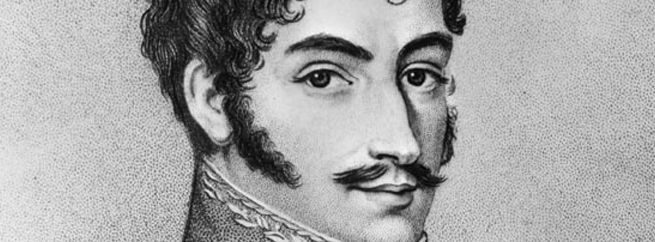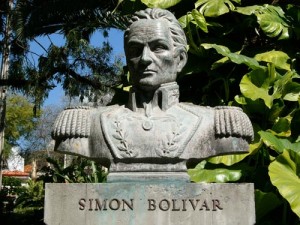
In Profile: Simon Bolivar – The Liberator
10 January, 2011Simon Bolivar is a name that echoes across South America. His name appears in titles of countries, currencies, and numerous place names and statues throughout the continent. Go anywhere in the Spanish-speaking world and people will know his name. Yet he died on his way to exile, convinced his life work would crumble. Sounds and Colours takes a look at the life, times and legacy of the man known as “El Liberador.”
Simón José Antonio de la Santísima Trinidad Bolívar y Palacios Ponte y Blanco was born into wealth and privilege in Caracas at the start of the 1780s the same year Britain abandoned claims to the United States and barely 6 years before the start of the French Revolution.
These were revolutionary times, and in every sense Bolivar belonged to the old guard. His family had come over from the Basque region of Spain as one of the early settlers and were granted estates laced with gold, silver, and importantly for the times, copper. They had social standing with both his father and mother belonging to the creole elite.
Simon received the best education, and towards the end of his teens departed for the deeply fashionable Grand Tour. A sort of aristocratic gap year (or years) in which the wealthy class’s offspring toured Europe to soak up the arts and science of modernity and antiquity.
Two things happened to set Bolivar apart. One was the death of his father, and the other the death of his mother, both happened before his tenth birthday. In themselves they are not particularly unusual events for the time, but it meant that Bolivar would have to find a new source of guidance. After the death of his mother, the family slave Hipolita took over his care. While increasing his sense of liberty and freedom, it was surely also key to the development of his anti-slavery ideals, a key breaking point between him and the American Revolution.
His mentor arrived in Don Simon Rodriguez, who sought to teach his stooge the ideals his legacy would be built around. When Bolivar was 14 he was forced to flee over accusations of conspiracy against the Spanish-controlled government and Simon entered a military academy formerly directed by his father.
The lessons from Rodriguez, practical knowledge from the military academy, and the vast access to family wealth would all play their part during his campaign for Independence later in his life.
Bolivar travelled extensively, and these trips produced a number of events which shaped the rest of Bolivar’s life. Firstly he married. While in Madrid, aged 19, he fell in love with María Teresa Rodríguez del Toro y Alaiza. Besotted and newly-married, they returned to Venezuela, where after barely two years of marriage she succumbed to yellow fever. Heartbroken, Bolivar vowed never to marry again.
He visited the United States, and saw first hand a country that had gained independence. He also witnessed the coronation of Napoleon in Paris. There is some debate about the effect this had on him. Some try to argue that he felt let-down as he saw the Revolution betray its ideals. Others say it inspired him as he wished to bring the same glory to his native land. The writing of the Gran Columbian constitution contained a lifelong president who was free to choose his successor giving credence to the inspiration theory. There appears a never ending re-branding of much of Bolivar’s beliefs that takes place as successive politicians try to recast themselves as being cut from the same cloth as the great continental hero.
It was his politics that became his undoing in the end. Following initial setbacks, Bolivar was involved in bringing independence to Columbia, Ecuador, Venezuela, Panama, and Upper Peru, later renamed Bolivia in his honour.
But as the post independence arguments started in Gran Columbia pro Bolivarians left the negotiating table. Bolivar felt he needed to declare himself dictator to prevent the collapse of the new state, which increased tensions. He was seen as being authoritarian and stubborn, and too keen on a centralised form of governance. Although his constitutions held checks to power, the presence of a life-long president was deeply unpopular.
During his lifetime two separate attempts were made on his life, the second foiled by his long-time lover Manuela Saenz. After two years of dissent Simon Bolivar resigned as President and planned to go into exile to avoid acting as a figurehead for anti-government feeling. But before he was able to set sail he was struck down with TB and died on the 17th December 1830 (read the excellent Gabriel Garcia Marquez novel The General in His Labyrinth for an excellent (fictionalised) account of his last days.)
Following his death his reputation declined as factions sprung up throughout Latin America. But as the new countries grew and found their feet his memory was used to help nurture a fledgling sense of nationhood. Two countries bear his name; Bolivia and Venezuela through its official title of Bolivarian Republic of Venezuela (their currency also bares his name).

As is the case with many figures in history, their actions played second fiddle to their legacy; how they are portrayed and for what they have come to represent, but Simon Bolivar can lay claim to having both an equally impressive life and legacy. He was known as The Liberator. A rich man who became the hero of the people. His name adorns streets through the continent, and statues appear dedicated to his name in London, Paris, Washington DC and numerous other town and cities throughout the world.
Simon Bolivar is perhaps the biggest name in Latin American history, and his shadow looms large over its present and shows no sign of abating.
Read more:
As well as The General in His Labyrinth, we would recommend John Lynch’s Simon Bolivar: A Life and Hugo Chávez presents Simon Bolivar: The Bolivarian Revolution as good sources for further explorations into the life of Simon Bolivar.
Follow Sounds and Colours: Facebook / Twitter / Instagram / Mixcloud / Soundcloud / Bandcamp
Subscribe to the Sounds and Colours Newsletter for regular updates, news and competitions bringing the best of Latin American culture direct to your Inbox.

